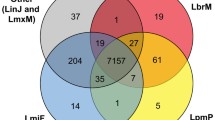Abstract
One mechanism that cells and organisms can employ to increase the level of gene expression is that of specific gene amplification. This process has been most intensively studied in tumor cells exhibiting amplification of cellular oncogenes and cultured mammalian cells selected for resistance to drugs (1,2), though it also occurs in a developmentally-regulated manner in Xenopus (3) and Drosophila (4). In the laboratory gene amplification has been shown to occur in human parasites, including drug-resistant lines of three species of Leishmania (5–3) and in Plasmodium falciparum (9).
Access this chapter
Tax calculation will be finalised at checkout
Purchases are for personal use only
Preview
Unable to display preview. Download preview PDF.
Similar content being viewed by others
References
Schimke, R.T., “Gene amplification in cultured animal cells”, Cell 37: 705–713 (1984).
Stark, G.R. and G.M. Wahl, “Gene Amplification”, Ann. Rev. Bioch. 53: 447–91 (1984).
Brown, D.D. and I.B. Dawid, “Specific gene amplification in oocytes”, Science 198: 739–742 (1968).
Spradling, A.C. and A.P. Mahowald, “Amplification of genes for chorion proteins during oogenesis in Drosophila melanogaster”, Proc. Natl. Acad. Sci. USA 77: 1096–2002 (1980).
Peixoto, M. P. and S.M. Beverley, manuscript submitted.
Ellenberger, T.E. and S.M. Beverley, in preparation.
Coderre, J.A., S.M. Beverley, R.T. Schimke and D.V. Santi, “Overproduction of a bifunctional thymidylate synthetase-dihydrofolate reductase and DNA amplification in methotrexate-resistant Leishmania”, Proc. Natl. Acad. Sci. USA 80: 2132–6 (1983).
Kink, J.A. and K-P. Chang, “Tunicamycin-resistant Leishmania mexicana amazonensis: expression of virulence associated with an increased activity of N-acetylglucoasminyltransferase and amplification of its presumptive gene”, Proc. Natl. Acad. Sci. USA 84: 1253–1257 (1987).
Inselburg, J., D.J. Bzik and T. Horii, “Pyrimethamine-resistant Plasmodium falciparum: overproduction of DHFR by a gene duplication”, Molec. Bioch. Parasit., in press.
Beverley, S.M., J.A. Coderre, D.V. Santi and R.T. Schimke, “Unstable DNA amplifications in methotrexate-resistant Leishmania consist of extra-chromosomal circles which relocalize during stabilization”, Cell 38: 431–439 (1984).
Beverley, S.M., T.E. Ellenberger, D.M. Iovannisci, G.M. Kapler, M.P. Peixoto, and B.J. Sina, “Gene amplification in Leishmania”, in Englund, P.T. and Sher, A. (eds.), Biology of Parasitism, MBL Lectures in Biology, in press (1988).
Beverley, S.M., T.E. Ellenberger, and J.S. Cordingley, “Primary structure of the gene encoding the bifunctional dihydrofolate reductase-thymidylate synthase of Leishmania major”, Proc. Natl. Acad. Sci. USA 83: 2584–2588 (1986).
Grumont, R. W.L. Washtien, D. Caput and D.V. Santi, “Bifunctional thymidylate synthase-dihydrofolate reductase from Leishmania: sequence homology with the corresponding monofunctional proteins”, Proc. Natl Acad. Sci. USA 83: 5387–5391 (1986).
Garvey, E.P., J.A. Coderre and D.V. Santi, “Selection and properties of Leishmania resistant to 10-propargyl-5, 8-dideazaf olate, an inhibitor of thymidylate synthetase”, Molec. Bioch. Parasitology 17: 79–91 (1985).
Beverley, S.M., in preparation.
Ellenberger, T.E. and S.M. Beverley, “Reductions in Methotrexate and folate influx in methotrexate-resistant lines of Leishmania major are independent of R or H region amplification”, J. Biol. Chem. 262: 13501–13506 (1987).
Fojo, A., A. Shinichi, M.M. Gottesman and I. Pastan, “Reduced drug accumualtion in multiply drug-resistant human KB carcinoma cell lines”, Cancer Res. 45, 3002–3007 (1985).
Riordan, J.R. and V. Ling, “Genetic and biochemical characterization of multidrug resistance”, Pharmac. Ther. 28, 51–75 (1985).
Schwartz, D.C. and C.R. Cantor, “Separation of yeast chromosome-sized DNAs by pulsed field gradient gel electrophoresis”, Cell 37: 67–75 (1984).
Carle, G.F. and M.V. Olson, “Separation of chromosomal DNA molecules from yeast by orthogonal-field-alternation gel electrophoresis”, Nucleic Acids Research 12: 5647–5664 (1984).
Scholler, J.K., S.G. Reed and K. Stuart, “Molecular karyotype of species and subspecies of Leishmania”, Molec. Bioch. Parasitol. 20: 279–293 (1986).
Comeau, A.M., S.I. Miller and D.F. Wirth, The chromosome location of four genes in Leishmania, Molec. Bioch. Parasitol. 21: 161–169 (1986).
Beverley, S.M., manuscript submitted.
Spithill, T.W. and N. Samaras, “The molecular karyotype of Leishmania major and map** of alpha and beta-tubulin gene families to multiple unlinked chromosomal loci”, Nucleic Acids. Research 13: 4155–4169 (1985).
Giannini, S.H., M. Schittini, J.S. Keithly, P.W. Warburton, C.R. Cantor and L.H.T. Van der Ploeg, “Karyotype analysis of Leishmania species and its use in classification and clinical diagnosis”, Science 232: 762–765 (1986).
Garvey, E.P. and D.V. Santi, Stable amplified DNA in drug-resistant Leishmania exists as extra-chromosomal circles. Science 233: 535–540 (1986).
Chu, G., Vollrath, D. and R.W. Davis, “Separation of large DNA molecules by contour-clamped homogeneous electric fields”, Science 234: 1582–1585 (1986).
Hieter, P., C. Mann, M. Snyder and R.W. Davis, “Mitotic stability of yeast chromosomes: a colony color assay that measures nondisjunction and chromosome loss”. Cell 40: 381–392 (1985).
Murray A.W., N.P Schultes and J.W. Szostak, “Chromosome length controls mitotic chromosome segreation in yeast”, Cell 45: 529–536 (1986).
Zakian, V.A., H.M. Blanton, L. Wetzel and G. Dani, “Size threshold for Saccharomyces cerevisiae chromosomes: generation of telocentric chromosomes from an unstable minichromosome”, Molec. Cell. Biol. 6: 925–932 (1986).
White, M.J.D., Animal Cytology and Evolution, Cambridge University Press, London (1973).
Solari, A.J., The 3-dimensional fine structure of the mitotic spindle in Trypanosoma cruzi, Chromosoma 78: 239–255 (1980).
Gibson, W.C. and M.A. Miles, The karyotype and ploidy of Try panosoma cruzi, EMBO J. 5: 1299–1305 (1986).
Stuart, K., S. Karp, R. Aline Jr., B. Smiley, J. Scholler and J. Keithly, Small nucleic acids in Leishmania, in Leishmaniasis: the first centenary 1885–1985, New Strategies for Control, D.T. Hart, ed., Plenum Press, N.Y., in press.
Hamers, R., N. Gajendran, J-C. Dujardin, K. Stuart, “Circular and linear forms of small nucleic acids in Leishmania”, in Leishmaniasis: the first centenary 1885–1985, New Strategies for Control, D.T. Hart, ed., Plenum Press, N.Y., in press.
Lopes, A., D.M. Iovannisci, D. McMahon-Pratt and S.M. Beverley, in preparation.
Author information
Authors and Affiliations
Editor information
Editors and Affiliations
Rights and permissions
Copyright information
© 1989 Springer Science+Business Media New York
About this chapter
Cite this chapter
Beverley, S.M., Ellenberger, T.E., Petrillo-Peixoto, M. (1989). Unstable and Stable Gene Amplification in Methotrexate-Resistant Leishmania Major and Natural Isolates of Leishmania Tarentolae. In: Hart, D.T. (eds) Leishmaniasis. NATO ASI Series, vol 171. Springer, Boston, MA. https://doi.org/10.1007/978-1-4613-1575-9_109
Download citation
DOI: https://doi.org/10.1007/978-1-4613-1575-9_109
Publisher Name: Springer, Boston, MA
Print ISBN: 978-1-4612-8862-6
Online ISBN: 978-1-4613-1575-9
eBook Packages: Springer Book Archive




